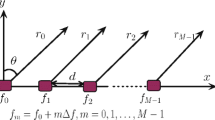Abstract
Frequency diverse array (FDA) radar with uniform inter-element frequency offset generates a beam pattern with maxima at multiple range and angle values. Multiple maxima property allows interferers located at any of the maxima to affect the target-returns. As a result the signal to interference noise ratio (SINR) and probability of detection decreases. In this paper, we propose a cognitive uniformly-spaced FDA with non-uniform but symmetric frequency offsets to achieve a single maximum beam pattern at the target position. Moreover, these non-uniform frequency offsets are calculated using well known mu-law formulae. The design sharpens or broadens the transmitted beam pattern based on the receiver feedback to achieve a better detection probability and an improved SINR as compared to the previous designs. The performance is also analyzed by considering the Cramer-Rao lower bound (CRLB) on target angle and range estimation.
Similar content being viewed by others
References
Antonik P, Wicks M C, Griffiths H D, et al. Frequency diverse array radars. In: Proceedings of IEEE Conference on Radar, Verona, 2006. 215–17
Antonik P. An investigation of a frequency diverse array. Dissertation for Ph.D. Degree. Bloomsbury: University College, 2009
Huang J J, Tong K F, Baker C J. Frequency diverse array with beam scanning feature. In: Proceedings of IEEE Antennas and Propagation Society International Symposium, San Diego, 2008. 1–
Secmen M, Demir S, Hizal A, et al. Frequency diverse array antenna with periodic time modulated pattern in range and angle. In: Proceedings of IEEE Conference on Radar, Boston, 2007. 427–30
Wang W Q. Phased-MIMO radar with frequency diversity for range-dependent beamforming. IEEE Sens J, 2013, 13: 1320–328
Zhuang L, Liu X Z. Precisely beam steering for frequency diverse arrays based on frequency offset selection. In: Proceedings of International Radar Conference “Surveillance for a Safer World– Bordeaux, 2009. 1–
Chen Y G, Li Y T, Wu Y H, et al. Research on the linear frequency diverse array performance. In: Proceedings of IEEE 10th International Conference on Signal Processing, Beijing, 2010. 2324–327
Wang W Q, Shao H, Cai J. Range-angle-dependent beamforming by frequency diverse array antenna. Int J Antenn Propag, 2012, 2012: 760489
Shao H, Li J, Chen H, et al. Adaptive frequency offset selection in frequency diverse array radar. IEEE Antenn Wirel Propag Lett, 2014, 13: 1405–408
Khan W, Qureshi I M. Frequency diverse array radar with time-dependent frequency offset. IEEE Antenn Wirel Propag Lett, 2014, 13: 758–61
Wang W Q, So H C, Shao H Z. Nonuniform frequency diverse array for range-angle imaging of targets. IEEE Sens J, 2014, 14: 2469–474
Khan W, Qureshi I M, Saeed S. Frequency diverse array radar with logarithmically increasing frequency offset. IEEE Antenn Wirel Propag Lett, 2015, 99: 1–
Sammartino P F, Baker C J, Griffiths H D. Frequency diverse MIMO techniques for radar. IEEE Trans Aerosp Electron Syst, 2013, 49: 201–22
Haykin S. Cognitive radar: a way of the future. IEEE Signal Process Mag, 2006. 23: 30–0
Xue Y. Cognitive radar: theory and simulations. Dissertation for Ph.D. Degree. Hamilton: McMaster University, 2010
Haykin S, Zia A, Xue Y, et al. Control-theoretic approach to tracking radar: first step towards cognition. Digital Signal Process, 2011, 21: 576–85
Haykin S, Xue Y, Setoodeh P. Cognitive radar: step toward bridging the gap between neuroscience and engineering. Proc IEEE, 2012, 100: 3102–130
Osman L, Sfar I, Gharsallah A. The application of high-resolution methods for DOA estimation using a linear antenna array. Int J Microw Wirel Tech, 2015, 7: 87–4
Grewal M S, Andrews A P. Kalman Filtering: Theory and Practice. Englewood Cliffs: Prentice-Hall, 1993
Kaneko H. A unified formulation of segment companding laws and synthesis of codecs and digital compandors. Bell Syst Tech J, 1970, 49: 1555–588
Huang X, Lu J, Zheng J, et al. Reduction of peak-to average power ratio of OFDM signals with companding transform. Electron Lett, 2001, 37: 506–07
Huang X, Lu J H, Zheng J L, et al. Companding transform for reduction in peak-to average power ratio of OFDM signals. IEEE Trans Wirel Commun, 2004. 3: 2030–039
Khan S U, Qureshi I M, Zaman F, et al. Null placement and sidelobe suppression in failed array using symmetrical element failure technique and hybrid heuristic computation. Progress Electrom Res B, 2013, 52: 165–84
King D, Packard R, Thomas R. Unequally-spaced, broad-band antenna arrays. IRE Trans Antenn Propag, 1960, 8: 380–84
Harrington R F. Sidelobe reduction by nonuniform element spacing. IRE Trans Antenn Propag, 1961, 9: 187–92
Willey R. Space tapaering of linear and planar arrays. IRE Trans Antenn Propag, 1962, 10: 369–77
Basit A, Qureshi I M, Khan W, et al. Hybridization of cognitive radar and phased array radar having low probability of intercept transmit beamforming. Int J Antenn Propag, 2014, 2014: 129172
Trees H L V. Optimum Array Processing. New York: Wiley, 2002
Wang W Q, Shao H. Range-angle localization of targets by a double-pulse frequency diverse array radar. IEEE J Sele Topics Signal Process, 2014. 8: 106–14
Wang Y, Wang W Q, Chen H, et al. Optimal frequency diverse subarray design with Cram′er-Rao lower bound minimization. IEEE Antenn Wirel Propag Lett, 2015, 14: 1188–191
Haykin S. Neural Networks and Learning Machines. 3rd ed. Englewood Cliffs: Prentice-Hall, 2009
Author information
Authors and Affiliations
Corresponding author
Rights and permissions
About this article
Cite this article
Basit, A., Qureshi, I.M., Khan, W. et al. Cognitive frequency diverse array radar with symmetric non-uniform frequency offset. Sci. China Inf. Sci. 59, 102314 (2016). https://doi.org/10.1007/s11432-015-0503-x
Received:
Accepted:
Published:
DOI: https://doi.org/10.1007/s11432-015-0503-x




